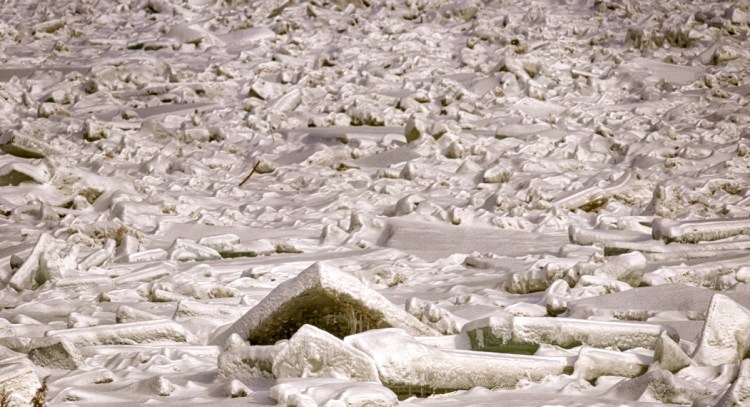Local, state and federal officials are keeping an eye out for worsening conditions on the Kennbec River as it flows through the southern part of Kennebec County and temperature rises this weekend.
A thaw earlier this month brought melting snow and rain to the region that created the conditions needed to cause ice on the river to break into chunks and flow downstream, causing the jam that now blocks the river between Farmingdale and Chelsea.
Last weekend, the river conditions led to flooding in both Augusta and Hallowell, where the fast-rising river inundated vehicles parked along Front Street.
While the on-again, off-again flood warning by the National Weather Service was canceled Friday, Gardiner Fire Chief Al Nelson said he’ll monitor river conditions over the weekend, as will the crew that staffs the fire station.
“Because the dam is north of us, it doesn’t cause any immediate issues for us,” Nelson said Friday. “The concern is if we get warm weather and it releases and re-dams the ice south of us because of the channel and the depth of the water, it becomes a problem for us.”
In Gardiner, the concern is different from that in Hallowell and Augusta, Nelson said. If rising water and ice block the outlet of Cobbosseecontee Stream into the river, water will fill the parking lot at the Hannaford supermarket on Maine Avenue.
“We can pretty quickly get businesses affected,” he said.
That would be a repeat of a scenario that has happened at least three times in roughly the same place.
Farmingdale Fire Chief Dana Mealey has spent his life in Gardiner and Farmingdale area, and he’s staring his 16th year as fire chief.
“I’ve seen it all,” Mealey said. He also has been monitoring the jam and is watching to see whether it will affect the Foggy Bottom Marina, where some campers are parked year-round.
While the jam has not been measured yet, he said it’s about as large as others he has seen, but perhaps not as high.
“Years ago, when I was probably a kid or a teenager, they used to use explosives to blow up the ice jams,” he said.
Now the state Department of Environmental Protection and the federal Environmental Protection Agency probably would frown on the practice, he said, but it usually worked.
Greg Stewart, chief of the Surface Water Hydrology Studies Section at the New England Water Science Center at the U.S. Geological Survey, said Friday that the shape of the river bed and the width of the river at that point are factors that lead to the formation of ice jams. “It’s a common spot. The water is deep and the ice sticks there,” Stewart said.
In 2010, USGS staff members measured the ice jam that piled up in the same place. It’s dangerous and hard to do, Stewart said, because holes have to be drilled in several places to make the calculation.
“In some areas, the jam was 12 feet thick,” he said. “It’s not all one continuous layer. It’s multiple layers, and there’s slush or frazzle ice that packs in and fills the voids.”
That slush holds the sheets of ice together, but the structure lacks the strength of a solid sheet of ice.
“It’s like a snowball that you keep in your freezer,” he said, meaning it’s frozen, but it’s not as solid as the ice in ice cube trays.
Ice jams occur because of runoff, he said.
When rain falls in the winter, some is absorbed by the snowpack if there’s any on the ground. But much of it runs off the frozen ground into the streams and rivers of the watershed. As the flow rises, it lifts the sheets of ice and starts to carry them downriver. Because of changes in the shape and width of the riverbed, Stewart said, the Kennebec has riffles and runs, where water flows over falls and across flat areas.
The ice that forms on riffles is thin and weak, he said. Ice crystals can’t stick to each other in moving water. Where the water slows down, in places where the riverbed is deep, thicker and stronger ice develops.
In Farmingdale, where the river is relatively deep, thick ice develops, he said.
That traps the chunks of ice in place.
Even as the ice stops, the river continues to flow. If the flow is constricted, water pressure can increase behind the jam.
The floods that result from ice jams can rise quickly, in a matter of minutes, he said. Open-water floods will rise over hours. “There are a lot of dynamics involved. If the ice jam continues to move because of the pressure of the water behind it, it could roll to the ocean,” Stewart said.
Right now, however, stretches of the Kennebec River are covered in thick sheets of ice that would prevent the ice from moving.
On Monday, USGS staffers are expected to capture images of the ice jam from the air and drill some ice cores by Richmond to evaluate the ice thickness.
“We’ll do it to help out the Coast Guard,” he said.
The U.S. Coast Guard is expected to send an icebreaker up the Kennebec River to clear a path for ice jam to travel.
In the meantime, if the warmer temperature causes more runoff, the rising flow of warmer water may eat away at the underside of the ice.
“You don’t really want a warm, sustained flow,” he said, because that would increase water pressure behind the jam.
“You want it to go slowly and softly,” he said.
Jessica Lowell — 621-5632
Twitter: @JLowellKJ
Send questions/comments to the editors.


